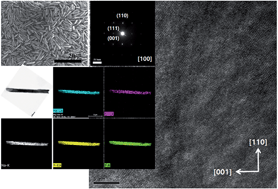Wavelength conversion effect-assisted dye-sensitized solar cells for enhanced solar light harvesting†
Abstract
In the present study, an enhanced solar light harvesting strategy based on the wavelength conversion effect is suggested for dye-sensitized solar cells (DSSCs). Incorporating β-NaYF4:Yb3+,Er3+ phosphor microcrystals as a component of the DSSCs enables wavelength conversion from infrared to visible light, which maximizes the absorption of visible light by the C106 organometallic dye and produces excess current, thus enhancing the quantum efficiency. It is demonstrated that the photocurrent density generated is increased by the wavelength conversion effect of the phosphor material. The introduction of up-converting β-NaYF4:Yb3+,Er3+ phosphor microcrystals dispersed in an iodide electrolyte and the use of an additional phosphor reflecting film increases the overall solar-to-electrical energy conversion efficiency (η) from 9.02% of reference DSSCs to 9.48 and 10.76%, respectively. DSSCs with phosphors contained in both the iodide electrolyte solution as well as an additional phosphor reflecting film show a highly enhanced overall efficiency of 10.90%. Herein, a strategy for effective wavelength conversion is investigated for enhanced solar light harvesting, and the results of the study contribute the most viable strategy for achieving maximum utilization of the solar spectrum.


 Please wait while we load your content...
Please wait while we load your content...